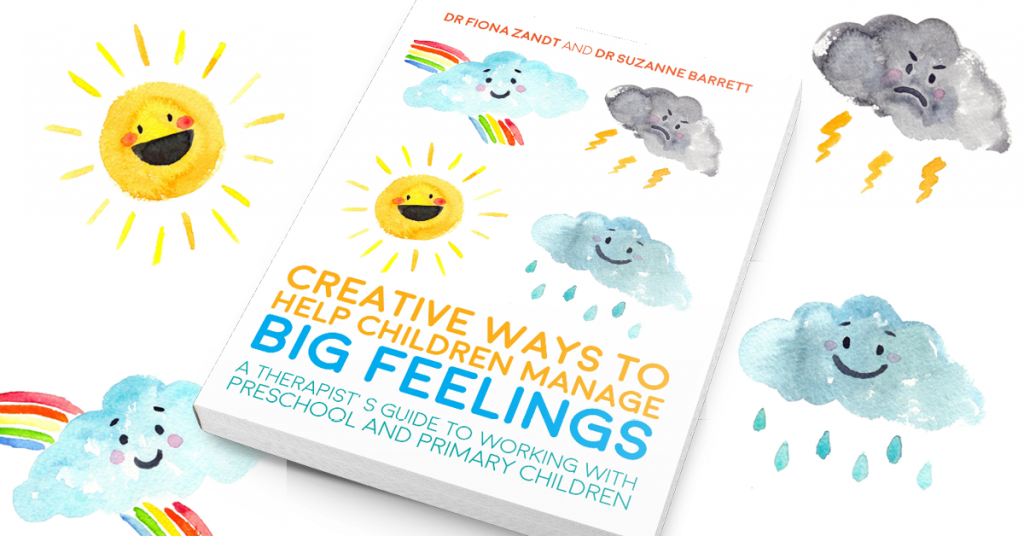Dr Fiona Zandt and Dr Suzanne Barrett, authors of Creative Ways to Help Children Manage BIG Feelings, are clinical psychologists who currently work in successful private practices in Melbourne. They each have over 15 years’ experience working with children and families.
Spider Squash, Temper Trail, Goodbye Worry Monster, and Beat the Anger Volcano are some of the board games we’ve created to help children with emotional difficulties. Board games are a great thing to make in therapy with children. While there are a number of excellent therapeutic board games on the market, making your own allows you to personalise them to meet the needs of the child you are working with. You can incorporate their interests and reflect on their individual strengths. Children often talk much more freely when engaged in play and the process of making the game together provides the opportunity for many helpful discussions. They require few materials, can readily be taken home, and are easily adapted for use with children with a wide range of emotional issues. Perhaps most importantly though making board games is fun.
In terms of materials, you will need some cardboard, markers, a die or a spinner, and some tokens to play with. Dice and tokens can be purchased cheaply on e-bay or from craft suppliers. Extra cardboard and scissors will be needed if you decide to add game cards.
The simplest way to make a board game is to use a basic board with different squares or spaces that you can move tokens on. You can download a template from our book, Creative Ways to Help Children Manage Big Feelings under the downloadable resources, or at the bottom of this article. Alternatively you can draw up a simple board yourself. Drawing it yourself allows you to adapt the shape of the spaces to suit the interests of the child. For example, for a child who is interested in space you can draw a series of planets to move the pieces along. Older children tend to enjoy creating a theme and using this to design the game. For example, a child who is fearful of spiders might create a Spider Squash game. Younger children often enjoy the process of making a game and will be happy with something simple like The Anger Game or The Worry Game.
One of the easiest ways to play is to have a starting space and a finish space, with the winner being the player who gets to the end first. Suggest that you add some ‘move forward’ options to some of the spaces and talk with the child about what is helpful for them. For example, if you are making a Beat the Anger Volcano game you could ask the child about what helps them to make good choices when they are angry. If the child suggests taking a big breath, you can ask how helpful that is and how many spaces that would move them forward. A child may also want to add things that are unhelpful for them as ‘go back’ spaces. Games are a great way of helping children to reflect on what they find helpful in challenging situations – their strengths and their strategies for managing their feelings.
Beyond the basic board game you can come up with a lot more options. Older children might like having cards that add another level of complexity to the game. For example, you might make choice cards that a child picks up each time they land on a square with an angry face. The cards might have a range of responses, such as “You tell someone how you are feeling – move ahead 5” or “You punch your friend in the nose – go back to the start”. You can also create cards or tokens that children need to collect during a game. For example, you might write “think”, “feel”, or “do” on some of the spaces on the board. When children land on the relevant space they can let you know one thing they might think, feel in their body, or do when they are feeling worried. The first to collect one of each of the tokens wins the game.
Games can also be useful early in therapy. A simple board with pictures of different feelings in the spaces can elicit some discussion around feelings with players needing to remember a time when they felt that way or describe what happens when they feel that way. Alternatively you can add questions on cards, such as “Name one thing that scares you” or “What is your happiest memory?” for children to pick up when they land on designated spaces.
Depending on the child and how elaborate they choose to make their game, there may not be time to play the game prior to the end of the session. If time allows playing the game together is often useful. For some children playing games can bring up lots of feelings around winning and losing and provides an opportunity to help the child work through these.
A wonderful thing about games is that children are often very happy to take them home to play. This provides a fun way of involving other family members and encourages conversations about feelings and helpful strategies at home. Playing games at home also provides children with another opportunity to review what they have talked about in therapy and to share with family members what they are learning in a fun and engaging way.
Click here for the board game extract
If you would like to read more articles like Fiona’s and hear the latest news and offers on our Social Work and Mental Health books, why not join our mailing list? We can send information by email or post as you prefer, and please also tell us about your areas of interest so we can send the most relevant information. You can unsubscribe at any time.
